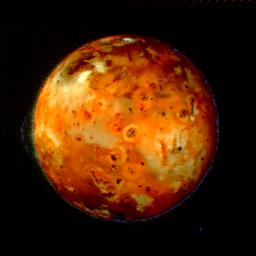
Io
Io, the innermost of the Galilean moons, is one of the most unusual bodies in our solar system. It is the third largest of Jupiter’s moons and has a diameter of about 3630 kilometers, slightly larger than Earth’s Moon (Arnett “Io”).
Io probably has the most geologically active surface in the solar system. Although it is less than a third of Earth’s size, it generates twice as much heat as the Earth. It has nearly no signs of impact craters because volcanoes are constantly covering its young, active surface. These volcanoes can spew sulfurous gasses and solids as high as 300 kilometers above Io’s surface at velocities of up to one kilometer per second (Morgan “Io”).
At first, scientists believed the lava flows on Io’s surface were composed mostly of molten sulfur. After they did more research with infrared technology, they found that these flows are too hot for liquid sulfur. They are more likely either molten silicate rock, a different material rich in sodium, or a variety of other materials. Among Io’s other surface features include non-volcanic mountains, lakes of molten sulfur, and volcanic vents (Arnett “Io”).
The many colors on Io come from the various gasses released from the moon’s volcanic activity. Charged particles that come from Jupiter’s magnetic field collide with these gasses, causing their colors to show. From these colors we can determine the composition of the gasses. If there is a white glow, it is sulfur dioxide. A red glow means there is oxygen present. Green areas are most likely oxygen and sodium (Newcott 134).
